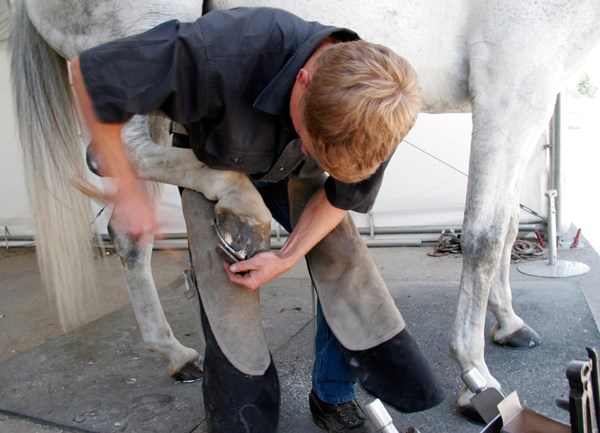
Safety around horses relies on good handling techniques. In particular, it is common for your veterinarian or farrier to request your presence while they are performing their procedures. You have an important job, one that keeps the professional safe. No matter how “broke” or quiet the horse, a horse can react suddenly and unexpectedly. Your job is to not be taken off guard so you can protect yourself, the professional, and the horse from harm.
Here some tips to think about while serving as the handler for your service professional. You might post this article for your boarders or use it as a conversation starter with your vet or farrier to see if they have other ideas to make their job easier and safer for all involved:
- Clear a working area so it is free of hazards or entrapments–use an area that is large enough for both people and the horse while allowing an escape route if the horse were to become agitated. Don’t feed the horse while the professional is working on him unless you are requested to do so as a distraction.
- During fly season, use fly spray before the professional arrives unless you are asked not to, and perhaps run a fan to further deter flies from landing on the horse while he is being attended to by the professional.
- Don’t talk on the phone or to others in the barn–keep your attention focused on the process at hand and the horse.
- Ask the vet/farrier where they want you to stand; don’t turn your back on the horse.
- Keep a good grip on the lead rope so you can readily control the horse when necessary; don’t hold him so tightly that he pushes back against the restraint, but don’t leave so much slack in the line that you don’t have control.
- Wear appropriate closed-toe footwear. Do not show up in sandals!
- If necessary, wear gloves when holding the lead line to protect against rope burn in case the horse pulls back.
- Never cross tie the horse for a procedure unless the vet/farrier agrees, and advise the vet/farrier if the horse has any “pulling” issues if the horse has to be tied to a solid post or trailer.
- Keep the horse’s head up. When his head goes down, it puts an abnormal amount of weight on the vet/farrier, and it also means you don’t have as good a hold on the lead line as necessary for safety precautions. It also means the horse is distracted and could startle suddenly.
- Never stand directly in front of the horse; always stay next to the shoulder on the side where the professional is working. Horses tend to move away from the handler if startled or anxious, so remain on the same side as your professional.
- Refrain from grooming or “picking” at the horse while procedures are being done.
- Reassure your horse by gentle hands on and a bit of verbal encouragement if the horse becomes anxious.
- Use nose or lip chain when necessary, but only if you are familiar with using a chain in this manner.
- If a horse is anxious by being alone, then bring a companion to a nearby paddock or stall or have another handler hold the second horse out of the way where your horse can see it and be calmed by its presence.
- Try not to schedule appointments around feeding time as that can make a horse difficult to work with if his attention is focused elsewhere.
- For the farrier, it helps if your horse is standing squarely on all legs that aren’t being worked on.
- Keep the horse’s mouth off the vet/farrier. Some horses might nuzzle or nibble while others will actually bite.
- If you have reason to reprimand the horse, advise the vet/farrier before you do so in case the horse jumps suddenly from your disciplinary action. Ask the professional to do the same. Agree ahead of time who will discipline the horse when it is needed.
- When someone is working on a hind leg, be sure to stay on the same side of the horse so you can turn his head toward you and the professional, which swings his haunches away from both of you. When the vet/farrier is working on the front leg, you might need to be on the opposite side, but check where they want you.
- Never allow a horse to run past the vet/farrier working on him; if the horse were to kick out, the professional would be hit.
These are just a few safety tips that can help keep you, your horse and your service professional from harm. Talk to your vet and farrier to determine their preferences, and encourage your boarders to follow their rules.


